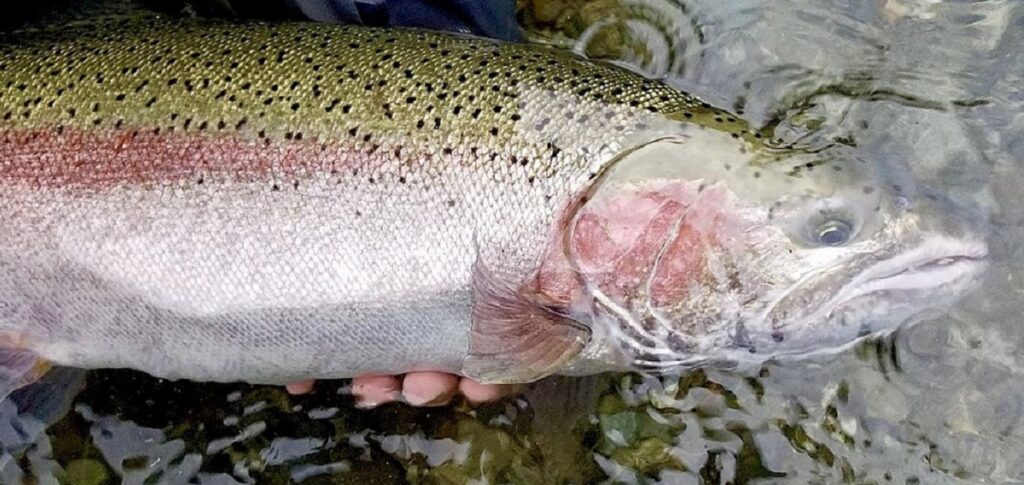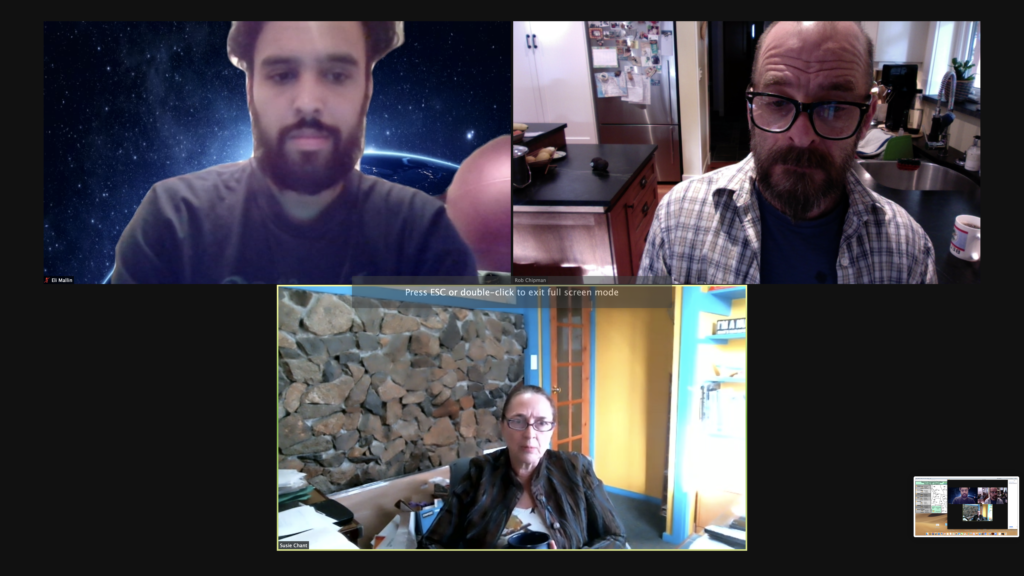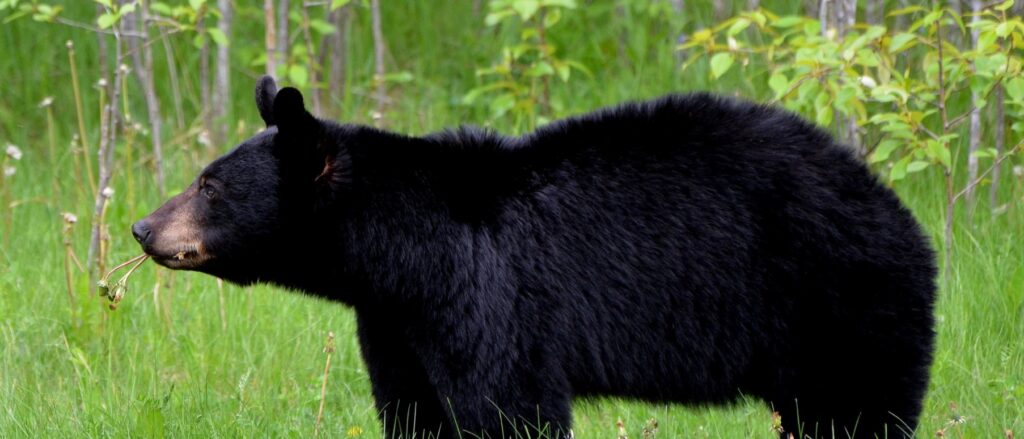Monthly Archives: February 2021
New research suggests 70% decline in diversity of B.C. sockeye salmon stock in past century
(From CBC)
Scales from sockeye salmon harvested more than a century ago show the fish returning to the country’s second largest watershed for salmon are 70 per cent less diverse than they were in 1913, according to a new study.
Scales from sockeye salmon harvested more than a century ago show the fish returning to the country’s second largest watershed for salmon are 70 per cent less diverse than they were in 1913, according to a new study from Simon Fraser University’s Michael Price.
Price, a PhD candidate in biological sciences, first undertook genetic testing two years ago of sockeye scales that have been collected since 1912 — before the introduction of motorized fishing boats on the river — to track how the abundance of sockeye salmon in the Skeena River had changed over time. He found declines of around 70 per cent.
Now he’s used even more of the fish scales, ones from 1913 to 1947, to show how the diversity of sockeye salmon returning to the Skeena River, which is the second largest producer of sockeye salmon after the Fraser River, has also seen a similar decline of around 70 per cent.
There are at least 13 genetically different sockeye salmon that spawn in the rivers or tributaries of the Skeena River watershed and that has not changed in 100 years, the study found.
However Price and co-author John Reynolds show that the vast majority of sockeye salmon now returning to the Skeena River to spawn, some 90 per cent, are of one type that originates in the Babine River, a tributary of the Skeena River.
Price says the predominant strain of sockeye in the Skeena River is wild — meaning fish that were not born in a hatchery or in a human-controlled spawning channel — which could affect the fish’s ability to thrive as climate change and other pressures on the fish progress.
“Diversity really is a barometer of resilience to provide the adaptive potential for the salmon to survive and thrive in an increasingly variable environment,” he said.
The research, done in conjunction with Fisheries and Oceans Canada, was published Monday in the Journal of Applied Ecology.
Price and Reynolds hope the new work will help with decision making in how to rebuild threatened salmon populations.
Sockeye salmon, known for their red hue when spawning, are a prized fish in commercial fisheries and are also important in the diets of marine mammals, bears and bald eagles.
Price said the reduction in sockeye diversity is a result of past fishing where selective gill-netting for larger fish was done, along with habitat degradation.
The study found hatcheries and controlled spawning channels have also contributed to a less diverse sockeye salmon population associated with the Skeena River watershed.
“This enhancement may increase abundances for some populations, but also can erode local diversity, homogenize life-history traits and further erode wild salmon abundances through competition in the ocean,” read the study.
Price says despite the decline in diversity, he still believes the fish have a future in B.C.
“Hope for me lies in the resilience of these animals,” he said. “They have persisted through changing climate over the last 10,000 years … they will persist in the future.”
Still, Price said that action is needed, such as limiting fisheries and restoring habitat, to help sockeye salmon stocks from deteriorating more.
“We are on the precipice of change,” he said.
With files from Bethany Lindsay
BCWF Calls for Moratorium on Lower Fraser Chum Gillnetting
There is a lucrative gill net fishery on the lower Fraser River that, unfortunately, has a very large and negative impact on Interior Fraser Steelhead.
Steelhead returns to the Thompson and Chilcotin Rivers has dropped to unbelievably dangerous levels.

From BCWF’s website:
The news that Interior Fraser steelhead (IFS) are spawning this month at historic low numbers is alarming. It requires immediate intervention by the Department of Fisheries and Oceans (DFO), the Province, and cooperation from lower Fraser River First Nations to ensure the conservation of these populations. The iconic and world-renowned Thompson River steelhead that numbered in the low thousands a few decades ago now number less than 200. The Chilcotin numbers in 2020 are less than 50. There is only one measure that can be implemented immediately to ensure that higher numbers of adult steelhead reach the spawning grounds on the Chilcotin and Thompson rivers next year (2021). Governments should announce a moratorium on the 2020 chum salmon gillnet fishery that incidentally catch and kill these steelheads as they migrate upstream during October-November.
DFO and the Province are responsible for the decline in these steelhead populations. Ineffective measures to mitigate the gillnet by-catch of IFS steelhead have been in place for over a decade. BCWF President Bill Bosch states, “these measures have been a failure as evidenced by the continuing downward numbers of steelhead, so the time has come for the responsible parties to get serious about steelhead conservation, which is the mandate of both government levels.” Bosch points out that conservation groups have sent numerous letters and have had meetings with governments over the last number of years to express concerns. These concerns have been ignored, and most often, there has not even been a reply to such communications! A review of the chum salmon fishery by an outside government expert is required.
For more information on this issue, as well as a simple way to send a letter to the government about this, visit the BCWF’s page “BCWF Calls For a Moratorium on Lower Fraser Chum Gillnet Fishery”
NSF&G President Meets with MLA Susie Chant
NSF&G President Rob Chipman met with newly elected North Van-Seymour MLA Susie Chant and Constituency Assistant Eli Mallin February 9 over Zoom.
This initial meeting was a great chance for our local MLA to get to know about our club, the BCWF, and the concerns about fish and wildlife management that club members have.
We discussed reconciliation, the lack of funding for fish and wildlife management, as well as the need for the increased application of science and Indigenous knowledge in decision making.
It’s important that meetings like this be regular, and that we hold them with as many MLAs as possible. Contact Rob at rob@robchipman.net if you’d like some help doing this sort of thing.

Fact versus Fiction: Large carnivore hunting and the social license to hunt

The B.C. Wildlife Federation has reviewed the paper “Large carnivore hunting and the social license to hunt.” [1] The paper infers hunters kill carnivores such as black bears for trophies and that only a minority hunt carnivores. A literature review related to hunters’ motivations and license sales in B.C. demonstrates this claim is unsupported by available evidence.
Research has shown that the top three reasons people hunt in B.C. are: 1) getting out in the wilderness, 2) the opportunity to harvest a legal animal and 3) spending time with friends and family. The least important factor for hunters in B.C. is the opportunity to harvest a trophy.[2]
The popularity of hunting in B.C. is on the rise. The number of licensed hunters has increased more than 20 percent, from 85,633 hunters in 2005 to 107,073 in 2020. Hunting in B.C. is shifting to being a more family-oriented activity, with increased female participation; people who are increasingly concerned with harvesting their own ethically sourced, sustainable protein are also taking up hunting.
According to government data, the number of black bear licenses sold over the past 15 years has increased more than 2.5 times from 14,362 to 36,744. Participation in black bear hunting has been on the rise since 2003, with hunters gracing their dinner tables with bear hams, roasts, sausages, stew and chili. Black bears provide hunters and their families with food, and the hides and skulls are often kept and utilized. The increase in black bear hunting is likely due to increasing black bear populations, new hunters recognizing black bear meat as high-quality protein, and declining opportunities for other species such as moose in British Columbia.
Given the province’s record low moose and endangered caribou populations, the harvest and intensity of managing carnivores will have to increase. With a landscape heavily marginalized by industrial extraction and urbanization, we will face the choice to either manage wildlife, including carnivores, through science-based management and traditional knowledge or have prey species continue to decline and, in the case of caribou, go extinct.
Works such as the paper “Large carnivore hunting and the social license to hunt” represent an unfortunate situation where anti-trophy hunting agendas are incorrectly vilifying hunters who choose to hunt carnivores for a variety of legitimate cultural and subsistence purposes.
“Hunting is growing in B.C. Hunters want to spend time in nature with friends and family while looking to fill their freezers with high-quality meat,” Jesse Zeman, BCWF Director of the Fish and Wildlife Restoration Program says. “Black bear and cougar meat are both exceptional table fare; at wildlife banquets and fundraisers across the province, cougar meat is always the first to disappear.”
Zeman points out that hunters in B.C. have been disproportionately affected by declining wildlife populations. In the 1980s, as many as 12,500 moose filled B.C. families’ freezers; today, that number is closer to 4,000. “Hunters are deeply concerned about the state of wildlife and habitat and are busy giving their money and time to try to turn that around,” Zeman notes. “It is unfortunate to see wildlife researchers so focused on stereotyping hunters when we have endangered caribou and record low moose populations staring us in the face.”
[1] Large carnivore hunting and social license to hunt Chris T. Darimont, Hannah Hall, Lauren Eckert, Ilona Mihalik, Kyle Artelle, Adrian Treves and Paul C. Paquet,
[2] https://bccf.com/sites/default/files/LEHReviewOct2009.pdf